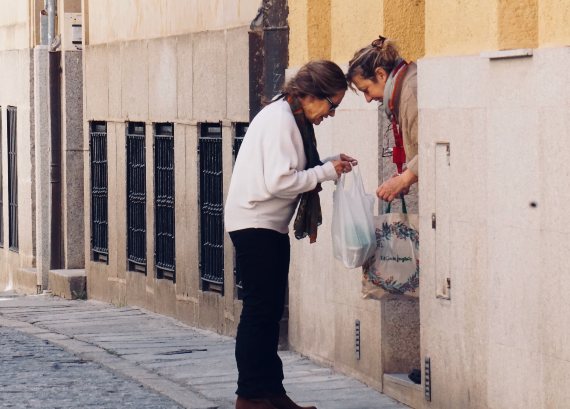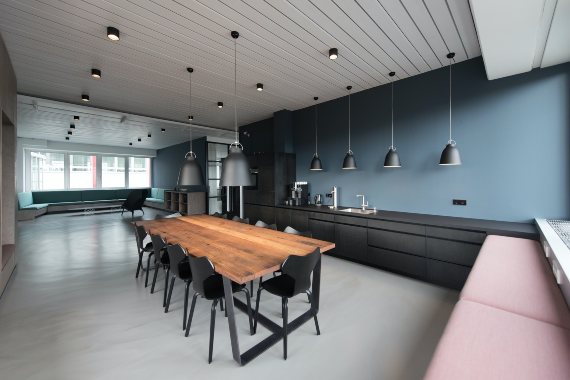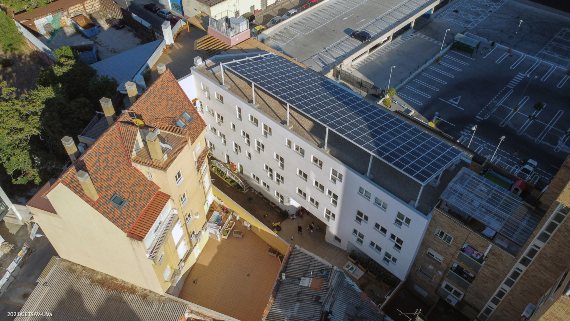Isabel Moreno, physicist, meteorologist and television host, interviews Iñaki Alonso, architect and CEO of Distrito Natural, to discuss sustainable housing and its relationship with climate change.
What do we mean by green housing? How did you get started in this field? And what does your work entail?
It has been more than 20 years since we started the environmental component, such as how to design buildings that have a different type of relationship with the environment: different relationships with energy, meaning buildings that produce energy; different relationships with water, with low carbon materials that do not emit CO2. This environmental component is essential to live in a context of energy crisis, climate change and heat waves.
Another fundamental aspect is collaborative, or co-housing, which are concepts we hear nowadays (co-housing, co-living, etc.).They refer to creating a different relationship between what is private and what is shared.
And how can we introduce this on a large scale – in a big city, for example?
I always say that this is a model for anyone who wants it. The idea isn’t to impose a model or replace another model, but there are more and more people who are interested in rebuilding their relationship with the environment. They are increasingly aware of what is coming, of the current context, and they also understand that it is possible to live in a different way.
I often give the example that you can ask your neighbor for salt, or anything else you need. It’s something that has always been done in small towns, but we have created an extremely individualized society in which it seems like going to ask a neighbor or asking a neighbor to do something, or being concerned about what might happen, is science fiction.

Today we have one of the biggest problems, a problem that the World Health Organization considers one of the great pandemics of the 21st Century: loneliness. We are increasingly more connected with technology and it seems like we live closer together in cities, and are hyperconnected. But actually, the loneliness index continues to rise.
And this is not limited to just older people. It also occurs among youth. Indexes on suicide and many aspects are somehow showing that the lack of social cohesion is very high. The society we are creating is highly individualized and has a number of problems that escape us.
Why do you think a more socially connected society could be more sustainable?
First, because interacting with each other is a human condition that has always existed. We are empathetic animals, and through that empathy, from these social relations, we also grow. We have always been this way. However, in recent years, we have developed a more individualized society.
In addition, in light of the problems and difficult contexts, being more connected also makes us stronger and more resilient.
The culture of mutual support and care in a society, or among neighbors, brings you an added value and makes you stronger. But also, collectively, we can tackle strategies like the energy communities that are so popular, water management, food management.

We make buildings where there is a group that brings organic food to the entire building, and the neighbors have reached an agreement and organized a way to manage the food, transportation, water, energy, care and mutual support. And this influences sustainability and the consumption habits in the building.
Sustainability is not limited to the design of the building. It is part of how that building is used. If it is used from a more collective standpoint, it will be more efficient in this aspect.
And how can architecture make society more connected?
First, by thinking of a space that I think is essential, which is that space between the door to the building and the door to your house. These are spaces that are given very little thought, they are abandoned. There is a lot of space between your house and the building door that we design from a collaborative architecture perspective so that relationships among people can take place. You can have anything there – from a shared kitchen to a play area for children.
Having a shared kitchen doesn’t mean that everyone doesn’t have their own kitchen in their house. This idea of a shared kitchen may sound strange but in the Basque Country it’s called Txoko, and it’s where meetings are held to make meals with friends.
You could also have a common laundry room instead of each home having their own washing machine. Having to go turn on the washing machine in the basement, or wherever it is, means you meet other people there and it helps to build relationships.
We call them community spaces in the sense that they build community.
That is the part of us that we call more like hardware, the physical part. Then there is a software component, which entails all of the social dynamics to build relationships and common goals. And that is where we also include the digital aspect – a series of applications that allow us to manage everything from food and energy to who is alone at home or has a problem and needs someone to buy groceries.
Therefore, there are two parts: the physical component in terms of spaces that are designed from an architectural perspective, and then the relationships, technology and social dynamics part.
And from an architectural standpoint, how do you make a home more sustainable?
The first thing to do is to use as little electricity as possible. We come from a culture where energy has been cheap. All modern movements have been based on very cheap energy, oil. In the 21st Century, we are entering a context of peak depletion of fossil fuels. And not only depletion, but their extraction and use is generating CO2 emissions that create other very big problems.
Construction is responsible for 36 percent of CO2 emissions or 40 percent of the energy needs. We therefore need to radically change our way of thinking and designing buildings: they should use as little energy as possible. This wasn’t taken into account before.
But you can go far beyond the regulations – not only by ensuring that they use little energy, but also making buildings that are capable of producing energy. This is what we can ‘prosumer’ buildings. It is a radical change in the way we see buildings.
How could we carry this out for people who live in a neighborhood of a big city? Would it be affordable for citizens?
Each of us fighting the war on our own is complicated. By reaching an agreement with the other neighbors in your building and establishing common strategies to improve the building, you will get much farther.

The first thing is to carry out insulation strategies – known as passive strategies – to reduce energy use. Then, try to ensure that the energy that is consumed comes from renewables.
And what would you say is the biggest challenge we face to apply this now? Society? Reaching an agreement with neighbors? More technical issues? Or a bit of everything?
I think we have resolved so many things from a technical perspective. We have the technology to do things very differently. The greatest challenge is mental – it’s such a big cultural transformation that we have to take the step forward and do it.
The biggest challenge is a cultural transformation of our way of life. We have to manage to reduce energy needs by at least 80 percent.
Comments on this publication